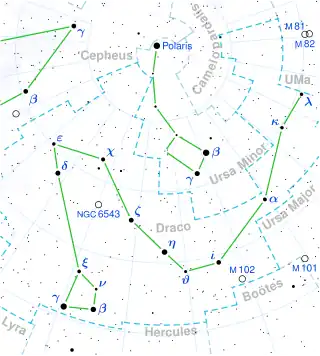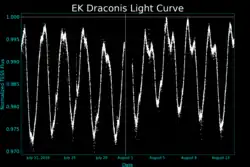EK Draconis
 | |
| Observation data Epoch J2000.0 Equinox J2000.0 | |
|---|---|
| Constellation | Draco |
| Right ascension | 14h 39m 00.210s[1] |
| Declination | +64° 17′ 29.98″[1] |
| Apparent magnitude (V) | 7.701-7.753 |
| Characteristics | |
| Spectral type | G1.5V |
| Variable type | BY Dra |
| Astrometry | |
| Radial velocity (Rv) | −21.12±0.19[1] km/s |
| Proper motion (μ) | RA: −135.751[1] mas/yr Dec.: −37.089[1] mas/yr |
| Parallax (π) | 29.0661±0.0217 mas[1] |
| Distance | 112.21 ± 0.08 ly (34.40 ± 0.03 pc) |
| Absolute magnitude (MV) | 4.9 |
| Details | |
| Mass | 1.1 M☉ |
| Radius | 1.2 R☉ |
| Temperature | 5,600 K |
| Age | 50-150 Myr |
| Other designations | |
| EK Dra, BD+64 1017, GJ 559.1, HD 129333, HIP 71631, SAO 16453, TIC 159613900, TYC 4176-540-1, 2MASS J14390026+6417299, SDSS J143900.24+641730.1[2] | |
| Database references | |
| SIMBAD | data |
EK Draconis (abbreviated EK Dra, also known as HD 129333 or HIP 71631) is a young active G-type main-sequence star in the Northern constellation of Draco. It is located approximately 111 light-years away from the solar system. With an apparent visual magnitude of 7.6, it is too faint to be visible to the naked eye and requires binoculars or a small telescope for observation.[3] is a Solar analog, similar in spectral type and mass to the Sun but significantly younger at 50–125 million years old.[4][5] The star is notable for its high levels of magnetic activity, including powerful superflares and coronal mass ejections (CMEs), which provide insights into the behavior of the young Sun and its potential impacts on early planetary systems. [6][7] EK Draconis is classified as a BY Draconis variable, exhibiting brightness variations due to large starspots and rapid rotation.
Characteristics
EK Draconis is a yellow dwarf star with a spectral classification of G1.5V. Its effective temperature is approximately 5,561 K, close to that of our Sun. Estimates of its mass range from 0.95 to 1.1 solar masses, with a radius of about 0.94 to 1.2 solar radii. The star's luminosity is roughly 0.97 times that of the Sun. Its metallicity, measured by iron abundance, is slightly higher than solar at [Fe/H] = 0.07. The star's surface gravity is approximately 4.47.[8]
The star lies at a galactic latitude of about 49° and a galactic longitude of 106°, placing it within the Milky Way disk. Its proper motion is -12.59 milliarcseconds per year in declination and -139.54 milliarcseconds per year in right ascension, with a radial velocity of -20.3 km/s, indicating it is approaching the Solar System.[3]
Companion
EK Draconis is a single-lined spectroscopic binary system, orbited by a low-mass companion. The companion is likely an M-dwarf star, with the system's orbital parameters determined through radial velocity measurements and speckle interferometry. The eccentricity of the orbit is approximately 0.13, and the semi-major axis is large, suggesting a wide separation. Detailed orbital elements have been refined using data from multiple surveys, confirming EK Draconis as one of the nearest young binary systems evolving similarly to the Sun.[9]
Observation & Stellar activity

EK Draconis rotates rapidly for a G-type star, with an equatorial rotation period of about 2.5–2.8 days and a projected rotational velocity of 16.4 km/s. The star exhibits significant differential rotation, with shear rates varying between 0.19 and 0.38 rad/d across observational epochs, leading to laptimes (the time for the equator to lap the poles) of 16–48 days. Its inclination angle is approximately 60°.[8][3]
The star's magnetic field is strong and dynamic, with average strengths ranging from 58 to 92 G over multi-year observations. It features a predominantly toroidal and axisymmetric field, with poloidal components that are often non-axisymmetric. No polarity reversals have been detected, but the field evolves over months, transitioning between toroidal-dominant and balanced poloidal-toroidal configurations. Surface features include large starspots at intermediate latitudes (40°–70°) and occasional polar spots, contributing to its variability as a BY Draconis variable star. Chromospheric activity is high, with indicators like the Ca II H&K S-index averaging 0.644 and log R'HK of -4.08. The Rossby number is approximately 0.2, indicating strong convective dynamo action influenced by rotation.[8][3]
EK Draconis has been extensively studied as a proxy for the young Sun due to its age and solar-like properties.[11] In April 2020, astronomers observed a superflare using NASA's Transiting Exoplanet Survey Satellite (TESS) and the Kyoto University's SEIMEI Telescope, followed by a massive coronal mass ejection (CME).[9] The superflare was tens to hundreds of times more energetic than typical solar flares, and the subsequent CME expelled plasma with a mass in the quadrillions of kilograms—over 10 times larger than the most massive known solar CMEs. The ejecta traveled at speeds up to 500 km/s (about 1 million mph). This event, the first optical spectroscopic detection of a supermassive filament eruption on a Sun-like star, suggests that such phenomena were more common in the Sun's youth and could have influenced the atmospheres of early Solar System planets, such as stripping gas from proto-Mars.[8][5][6][7]
Multi-wavelength campaigns, including observations in 2021–2023, have further documented prominence eruptions associated with superflares, enhancing understanding of stellar space weather. Magnetic field mapping using instruments like ESPaDOnS and NARVAL from 2006 to 2012 has revealed the star's complex dynamo processes.[8]
Significance
As a young Sun analog, EK Draconis provides insights into the Sun’s behavior ~4.5 billion years ago. Its rapid rotation and magnetic activity suggest the early Sun produced similar superflares and CMEs, potentially affecting the atmospheres of early Earth and Mars. The 2020 CME observation highlights implications for planetary habitability in young stellar systems.[3]
See also
Reference
- ^ a b c d e f Vallenari, A.; et al. (Gaia collaboration) (2023). "Gaia Data Release 3. Summary of the content and survey properties". Astronomy and Astrophysics. 674: A1. arXiv:2208.00211. Bibcode:2023A&A...674A...1G. doi:10.1051/0004-6361/202243940. S2CID 244398875. Gaia DR3 record for this source at VizieR.
- ^ "EK Draconis". SIMBAD. Centre de données astronomiques de Strasbourg. Retrieved 2025-08-12.
- ^ a b c d e "Star EK Draconis". Stellar Catalog. Retrieved 1 March 2025.
- ^ "Astronomers spy record-breaking eruption on young sunlike star". Space.Com. Retrieved 1 March 2025.
- ^ a b "EK Draconis illuminates an unimagined picture of how superflares may affect interplanetary space through coronal mass ejections". NSO. Retrieved 1 March 2025.
- ^ a b "A young sun-like star may hold warnings for life on Earth". University of Colorado Boulder. Retrieved 1 March 2025.
- ^ a b "Fiery Dragon's Breath May Scorch Young Planets". NAOJ. Retrieved 1 March 2025.
- ^ a b c d e Waite, I. A.; Marsden, S. C.; Carter, B. D.; Petit, P.; Jeffers, S. V.; Morin, J.; Vidotto, A. A.; Donati, J. -F.; BCool Collaboration (2017). "Magnetic fields on young, moderately rotating Sun-like stars - II. EK Draconis (HD 129333)". Monthly Notices of the Royal Astronomical Society. 465 (2): 2076. arXiv:1611.07751. Bibcode:2017MNRAS.465.2076W. doi:10.1093/mnras/stw2731.
- ^ a b König, B.; Guenther, E. W.; Woitas, J.; Hatzes, A. P. (2005). "The young active binary star EK Draconis". Astronomy and Astrophysics. 435 (1): 215. arXiv:astro-ph/0501608. Bibcode:2005A&A...435..215K. doi:10.1051/0004-6361:20040462.
- ^ "MAST: Barbara A. Mikulski Archive for Space Telescopes". Space Telescope Science Institute. Retrieved 16 August 2025.
- ^ Namekata, Kosuke; Ikuta, Kai; Petit, Pascal; Airapetian, Vladimir S.; Vidotto, Aline A.; Heinzel, Petr; Wollmann, Jiří; Maehara, Hiroyuki; Notsu, Yuta; Inoue, Shun; Marsden, Stephen; Morin, Julien; Jeffers, Sandra V.; Neiner, Coralie; Paudel, Rishi R.; Avramova-Boncheva, Antoaneta A.; Gendreau, Keith; Shibata, Kazunari (2024). "Multiwavelength Campaign Observations of a Young Solar-type Star, EK Draconis. II. Understanding Prominence Eruption through Data-driven Modeling and Observed Magnetic Environment". The Astrophysical Journal. 976 (2): 255. arXiv:2410.05523. Bibcode:2024ApJ...976..255N. doi:10.3847/1538-4357/ad85df.